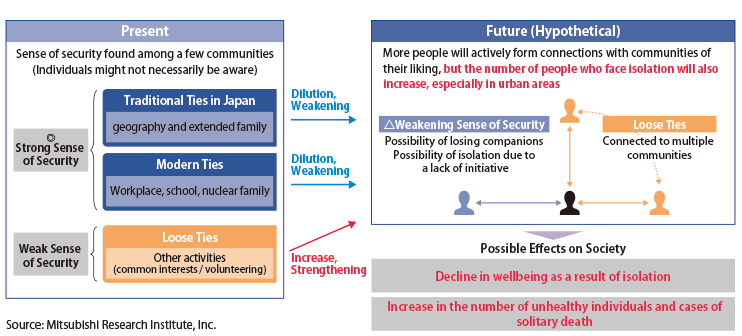Healthy life expectancy will be extended by the application of regenerative medicine and the development of preventive treatments such as the use of rare sugars*1. In the future, anti-aging treatments may also be realized thanks to advancements in technologies such as sirtuin activators*2. While the economic situation and changes in values largely affect working hours, developments in AI and similar technologies will likely lead to a further decrease in working hours and an increase in leisure time as the average annual number of hours worked has already decreased about 25% from 1960 to 2010, from approximately 2,400 hours to 1,800.
In Japan, communities that have been primarily rooted in ties such as kinship and geography will weaken with the progress of urbanization. According to our own calculations, Japan will see an acceleration in urbanization through 2050 with an increase in the percentage of population living in regional prefectural capitals and other core cities. The country as a whole will be faced with an intensified issue of isolation.*3
A comparison with other countries offers an even clearer perspective on the severity of isolation in Japan. According to the OECD (2005) a survey of social isolation found that the “proportion of respondents who rarely or never spend time with friends, colleagues or others in social groups” was 15.3% for Japan, greatly exceeding the global (OECD-20) average of 6.7%. There is also a growing awareness of societal issues related to isolation such as effects on health and the increased incidence of solitary deaths.
Increased isolation and loneliness have been recognized as important issues even at the global level and represent important challenges for the future of society. While many studies have been conducted from family and community perspectives, MRI has structured isolation using individual personality traits. At the present stage, we foresee communities based on multiple loose connections, instead of traditional ties of kinship or geography, as one future solution for those struggling with isolation(Figure). MRI will develop a roadmap for communication technology based on advancements in brain tech and virtual reality, methods for eliminating individual isolation and a proposal for new types of community in the coming era.
*1:Rare sugars are monosaccharides (the smallest units of sugar) and sugar alcohols that are rarely found in nature. It is becoming clear that such sugars have a variety of physiological properties that are beneficial to people in modern society. (Adapted from the website of the Association for the Promotion of Rare Sugars)
*2:A class of genes discovered by the Massachusetts Institute of Technology in yeast sirtuins have been found to inhibit the generation of active oxygen and prolong the life of organisms.
*3:According to calculations in Future Society 2050 published by MRI in October 2019, the share of the population living in regional prefectural capitals and other core cities is expected to increase from 12% to 17% by 2050. Please refer to Future Society 2050 for details.

